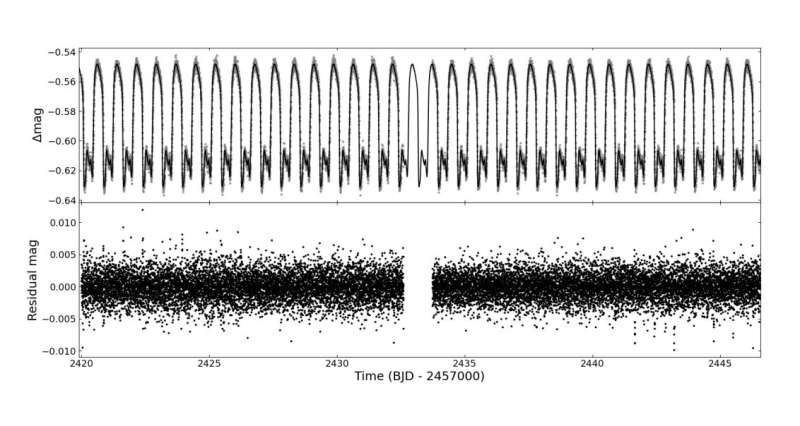Upper panel: prewhitened light curve of HD 345439. Bottom panel: residual magnitudes after subtracting the light curve with the periodic signal. Credit: Shen et al, 2022
Using the Nanshan One-meter Wide-field Telescope (NOWT), Chinese astronomers have performed multi-color photometric observations of a rapidly rotating magnetic star known as HD 345439. Results of this observational campaign, published Nov. 1 on the arXiv pre-print server, shed more light on the properties of this star.
Magnetic stars of spectral type O, B, and A (OBA) are relatively rare—for instance, only 11 magnetic O-type stars are known to date. Observations show that they exhibit unique phenomena, such as cyclic variability in line profile morphologies. Given that the formation mechanism of magnetic fields in these stars is still not fully understood, studying objects of this type is essential to advance our knowledge about this process.
Located some 7,000 light years away from the Earth, HD 345439 is a helium-rich massive magnetic star exhibiting extremely strong, large-scale magnetic fields and fast rotation. Recent observations have found that the star is about seven times larger and nearly nine times more massive than the sun. HD 345439 has longitudinal magnetic fields showcasing periodic variability with an amplitude of some 2–3 kG, and the polar magnetic strength of this star reaches 10 kG.
In order to get more insights into the properties of this peculiar star, a team of astronomers led by Dong-Xiang Shen of the Xinjiang University in Urumqi, China, conducted photometric observations of HD 345439 in late 2020.
"Here, we aim to provide more detailed characteristics of the rapidly rotating magnetic early-type star HD 345439 using NOWT photometric observations," the researchers wrote in the paper.
According to the study, the shapes of the light curves of photometric observations of HD 345439 show a typical double asymmetric S-wave feature arising from the star's magnetic clouds. The researchers assume that such a feature may be caused by an offset between the center of the dipolar magnetic fields and the rotation axis.
In general, the profiles and amplitudes of the light curves were found to be approximately consistent with the archival data. The new observations found no evidence of pulsating behavior in HD 345439.
NOWT data allowed Shen's team to derive the rotational period of HD 345439. It was calculated that it takes this star nearly 18.5 hours to rotate around its axis, which is consistent with previous estimates.
New research found that HD 345439 is smaller and less massive than previously thought as it has a radius of about 5.6 solar radii and a mass of eight solar masses. The results suggest that the star is approximately 26.8 million years old, has an effective temperature of around 22,000 K, and its metallicity is at a level of -0.5. The distance to HD 345439 was estimated to be 6,982 light years.
More information: Dong-Xiang Shen et al, Photometric properties and stellar parameters of the rapidly rotating magnetic early-B star HD 345439, arXiv (2022). DOI: 10.48550/arxiv.2211.00271
Journal information: arXiv
© 2022 Science X Network
























